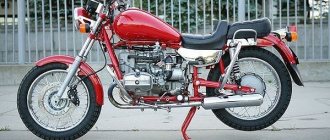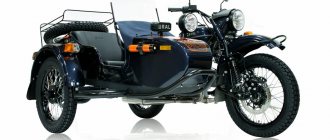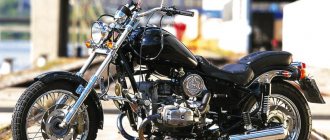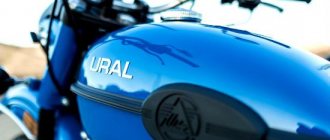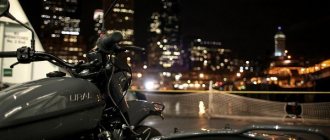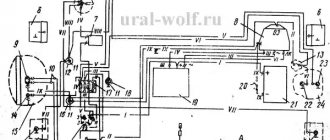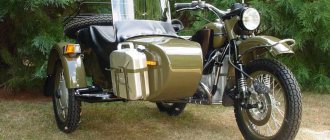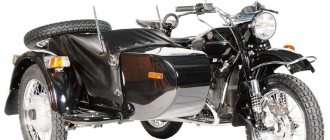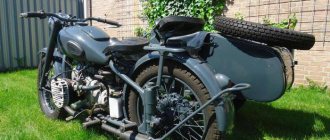At the end of the 30s of the 20th century, a meeting was held at the People's Commissariat of Defense of the USSR, the main topic of which was the analysis of new models of military equipment, and the prospects for adopting the best of them into service with the Red Army. One of the types of equipment that the Red Army urgently needed was an army motorcycle. After analyzing the samples, the best motorcycle was the German company BMW - R71.
By that time, it had already been in service with the Wehrmacht for several years. It was decided to use this car as the basis for a new motorcycle. The development of the domestic version of the R71, designated M72, took several years. Therefore, mass production of the domestic motorcycle began shortly before the war - in the spring of 1941. Production was mastered at the Moscow Motorcycle Plant (MMZ).
But due to the rapid German advance on Moscow, by the end of October 1941 the plant was evacuated to the city of Irbit. The territory of a former brewery was provided as a site for the plant. The new enterprise became known as IMZ (Irbit Motorcycle Plant). Serial production of the M72 IMZ began at the end of 1941.
The M72 was initially equipped with a lower-valve engine, which even at the time of the creation of the machine had few reserves for improvement. This circumstance prompted IMZ designers to create a new overhead valve engine. This device went into production in 1957. A transitional model motorcycle equipped with such an engine was designated M61. Motorcycles M72M and M61 were produced in parallel until 1960.
Since 1961, simultaneously with the assembly of the now old M61 model, the production of the new Ural M62 model began. The motorcycle came complete with a sidecar. This stroller was single and equipped with a luggage compartment located behind the back of the seat. The stroller was attached to the motorcycle frame using collet joints and braces at four points. The stroller wheel had a lever suspension with a shock absorber. Suspension travel is up to 120 mm. The spare wheel was mounted on the luggage compartment lid of the stroller. The general appearance of the Ural M62 motorcycle can be seen in the photo below.
History of the development of the model design
The Ural M 62 motorcycle, 650 cm cubed, was created in 1961 by the Irbit Motorcycle Plant on the basis of the M 72M motorcycle.
After the Irbit plant created a new forced overhead valve engine and began installing it on the M 72 motorcycle, a transitional model appeared - the M 61.
The M62 motorcycle is a modernized model of the M 61 and differs from it in the design of the power transmission, chassis and ignition system devices. The main technical parameters of the engine remained unchanged.
The engines are overhead valve and were manufactured on the basis of the M 72M engine, therefore only their distinctive features are described in comparison with the design of the M 72M engine.
The crank with connecting rods is an integral unit, which differs from the corresponding unit of the M 72M engine in the length of the connecting rod and the distance from the axis of the axle to the axis of the crank pin.
A second oil scraper ring is installed on the lower part of the piston skirt.
The cylinders are interchangeable and in the upper part have four holes for the head mounting studs and two holes into which the pusher rod tubes are pressed.
To drain oil from the valve box into the crankcase, there is a tube passing through the cylinder ribs.
Diagram of the gas distribution mechanism of the M 62 engine.
The gas distribution mechanism of the described engine is an overhead valve mechanism, which is its fundamental difference from the M 72M engine.
The valve disc diameter is 35mm, the stem diameter is 7.5mm and the overall valve length is 91mm. The valves move in guides pressed into the body of the cylinder head. The gap between the bushing and the valve stem is 0.05-0.1 mm.
The camshaft has four camshafts, which differ from the cams of the M72M engine shaft in their shape and location, which makes the camshafts not interchangeable.
Tips with a hemispherical recess are pressed into the body of the pushers.
The thermal gap (0.1 mm) between the valve stem and the rocker arm is adjusted with the valve box cover removed.
Lubrication system
Valves and rocker arms are splash lubricated. Through holes located at the end of the pushrod guide bushings and the rod casing, oil enters the cylinder heads and is sprayed there by the valve springs.
Supply system
The M 61 engine has two K-52 carburetors, and the M 62 engine has two K-38 carburetors. Two K-37 carburetors can be installed on the M61 motorcycle engine.
Motorcycle control mechanisms Ural M 62
The control mechanisms of the Ural M 62 motorcycles are divided into hand and foot.
The clutch and brake levers of the front wheel of the M-61 motorcycle are located on the handlebars with the ends outward.
The carburetor throttle control knob is a single cable coil type. The cable in the handle is wound onto the drum and, through a special adapter, transmits force to the throttle valve control cables of each carburetor.
The M62 motorcycle uses a two-cable throttle control. A chain is wound onto the drum, rigidly connected to a slider, to which the throttle valve control cables are attached.
There is no ignition timing lever on the M62 motorcycle, since it is equipped with an automatic ignition timing device.
The brake control mechanisms of the Ural M 61 and M 62 motorcycles are identical in design.
The brake pads of the hand and foot brakes are interchangeable.
Each pair of pads is tightened by two springs.
The expanding fists of the hand and foot brakes have small slots on their outer ends on which the levers are secured.
The hand brake lever is connected to a cable, and the foot brake lever is connected to a control rod.
The hand brake is adjusted using the adjusting screw on the brake drum cover.
The foot brake is adjusted using the adjusting wing nut at the front end of the brake rod.
M-62 "Ural", differences in design between motorcycles of different years of manufacture.
Let me transfer some materials from the thread “M62, the tale of the Urals” Acquisition of Artem
YS:
Due to the death of the photo file, we are moving to Yandex. I duplicate the photo from the post about the lid.
Retroman (Sat, 01/11/2014 - 03:42) Eugene, don’t mislead people or clarify at what point they started riveting. My M-62 was produced in February 1963, the plate is on the screws.
Eugene (Sat, 01/11/2014 - 11:30)
I could of course be wrong, just personal observation from May 1963. If your M62 has a plate the same size as the M61 and has bolts, then we can talk about originality. On M62, smaller signs were riveted. Apparently they were still turning the bolts at the beginning of the year.
Digital-Fox (Tue, 11/11/2014 - 17:27)
M62, 1962, screws.
BESToloch (Tue, 04/11/2014 — 18:23)
https://photo.qip.ru/users/bestoloch72/96534305/?page=1 Flashlights should be like this. They are there, they were given as an accessory to the motorcycle. Unfortunately, to install the windshield, the original cover on the ignition switch was broken. (
YS:
Somehow I myself am already confused))). I recently bought a headlight assembly for an M-62 for a friend from a good person from Chelyabinsk. 99% that the headlight is original, the motorcycle was made in June 62, so the carbolite cover is also ordinary, without the letter K. The speedometer from this headlight dates back to April 62. Here is a photo.
It seems that in the USSR, headlights for heavy motorcycles were made only in Kirzhach. Or am I wrong?
ki.serzh (Wed, 05/11/2014 — 16:56)
The letter “k” in the letter “O” is the mark of the Red October plant (Kirzhach), where these headlight covers were manufactured. Retroman (Wed, 05/11/2014 - 18:56)
M-62 February 1963, regular carbolite slider, without the letter K. Metal base of the valve as in the photo.
YS (Wed, 05/11/2014 - 20:04)
Mine is also February 1963. I have big doubts that my headlight or slider was replaced... Eugene (Wed, 05/11/2014 - 20:28)
If there are no other opinions, maybe we can assume that both options were installed, depending on the delivery of these covers? We need to collect statistics on the M62 - we ask owners to speak out. YS (Wed, 05/11/2014 - 20:42)
Well, it’s somehow not serious about two options at the same time, if you start from the fact that the headlights were produced by one factory. Why this confusion?! The plant itself provided the full production cycle and it was not logical to make two types of caps in parallel. I'm all for statistics. Eugene (Wed, 05/11/2014 - 23:18)
You can find out in the Irbit museum whether headlights with a slider in this design were supplied to the factory, when and for which models.
BESToloch (Fri, 23/01/2015 — 07:01)
It seems to me that the situation is like this. Slider caps were the first to be installed on the Izh-56 in the late 50s. Then, as I understand it, similar caps were made on the M-62. And then someone came up with the brilliant idea to unify these parts with the same functionality and put the same caps on all headlights from different factories. Subsequently, such covers were placed on Izhi, Urals, Dnieper, Minsk and Kovrovtsy.
BESToloch (Wed, 05/11/2014 — 19:25)
Here is a photo of the base without the engine. Stamped protrusions protrude from the base to the right and left of the slot, which will not allow a regular slider to stand in this place. https://photo.qip.ru/users/bestoloch72/96534305/133388364/#mainImageLink
Retroman (Thu, 06/11/2014 - 13:55)
I will surprise you, dear! Such projections are present on all bases of this type. Moreover, they in no way interfere with any crawlers, absolutely. If you don’t trust it, disassemble any complete lock bolt with a regular carbolite slider - a surprise will await you!
ki.serzh:
The cover for a regular slider does not have these guides.
BESToloch:
For clarity, there are two photos side by side.
YS (Thu, 06/11/2014 — 19:10)
To develop the topic, the promised photos. My M-62. Issue February 1963. I mentioned this motorcycle relatively often, but few people saw it. Single for now. The motorcycle is almost ready, just a few small things left. There is a sidecar, but it is stored far away, separate from the motorcycle. It is preserved and complete as a motorcycle. There is even a pump in the trunk))). The rear wing gate is now a spare one, in mediocre condition, but in the correct color. The original one was removed to transport the motorcycle and is currently stored with the sidecar. The photos are “clickable”; there are several more in the album on the photo file. Eugene (Fri, 07/11/2014 - 00:47)
Is there still a seal on the speedometer in the headlight? I see pp31 from M61, and the generator is 414? YS (Fri, 07/11/2014 - 06:58)
I looked into the headlight only once, I changed the lamp, so I don’t remember about the seal. There is a seal on the gearbox, it is visible in the photo. There was a dilemma with the relay regulator; I have two of them with a suitable release date. I never found a catalog for the M-62. The instructions also don’t say anything about the RR brand, but the relay that is there in the pictures does not in any way resemble the PP302. Therefore, I decided to install the PP-31. If suddenly someone has a source with an exact indication of the model of the relay being installed, please let me know, if I was wrong, I’ll replace it, it’ll take 5 minutes. Generator G-11A, also with a selected release date. Eugene (Fri, 07/11/2014 - 10:40)
A pair of g11a and pp31 were installed on the very first motorcycles. We used p302 under the more powerful g414. Retroman has the 62nd of the same month - what's there? Again, the museum can give accurate information.
YS (Fri, 07/11/2014 - 14:01)
Where does this information come from? There are quite a lot of complete M-62s and their engines with a short generator, and all the 414s that I saw on engines and motorcycles were much younger than them. I'm not saying that I'm right, anything is possible, but I haven't found any direct evidence for or against it yet. I wouldn’t count too much on the museum, I can give you contacts, then you’ll tell me what happened. Let's wait to see what Retroman says.
YS (Fri, 07/11/2014 - 16:56)
There is documentation, it’s not even discussed, but there are many different things. But the books of those years cannot be trusted in everything, and some are generally better not to be opened in relation to the complete set. (This was a reply to the message below) Eugene (Fri, 07/11/2014 - 16:25)
The museum has factory technical documentation for the model - a reliable source of information on how it should be. This is not our speculation on the configuration of the copies that were passed around. There is also literature from those years. The telephone number and mail address of the museum can be found. If I'm in the mood, I'll check the time there.
greyhound327 (Fri, 07/11/2014 - 17:35)
By chance, a photo of G-414, dated September 1959, was preserved... By the way, does the motorcycle have an air filter with a carbolite cover? If so, is the top spring plate riveted to it? YS (Fri, 07/11/2014 - 17:53)
That's right, the lid is carbolite with a riveted plate.
Retroman (Wed, 12/11/2014 - 19:06)
Mine had G-11A and RR-31, the former owner replaced them with G-414 and RR-302 when the ends of the windings on the generator began to fly out of the collector lamellas, but the generator itself and the relay were preserved. I'm currently preparing the devices for restoration.
YS (Wed, 12/11/2014 - 20:17)
If it’s not difficult, look at the release date of the generator and RR. I wonder if it’s month to month or what it was like in ’63? I have a spare motor from 1965, there is a generator of the same month as the motor, and how did they manage to do it?! Retroman (Thu, 13/11/2014 - 18:14)
Generator - December 1962, relay - January 1963. I posted the photo here: I’m slowly looking for a body or a dead relay of a similar or close date, I have one thought.
NigaMan (Fri, 07/11/2014 - 03:50)
What signal should there be? Otherwise my c37 doesn’t fit into place, the wing is in the way. YS (Fri, 07/11/2014 - 07:05)
The S-37A is standing almost end-to-end, but it doesn’t touch anything. Check if the fender or fork are deformed.
greyhound327 (Wed, 12/11/2014 - 11:32)
The question has arisen: in connection with what the numbering of the gearbox, a design a la M-72, was “reset to zero”. Statistics show that this happened at the stage of production of the M-61. From the main versions: the transition to a “flat” gearbox foot, or a fine spline design gearbox shafts. Or did this happen at the end of production of the M-72? What are your opinions?
BESToloch (Wed, 12/11/2014 — 20:33)
The numbering was reset due to the fact that they began to manufacture a gearbox housing of a different configuration. I can’t say when the checkpoint numbers were reset. The frame and engine numbers for the M62 started from 0.
greyhound327 (Wed, 12/11/2014 - 21:54)
Do you mean eliminating the tide under the center stand spring mounting pin?
YS (Wed, 12/11/2014 - 22:34)
If you dig, there were a lot of changes in the appearance of the crankcase, the “windows” under the air damper look different, and the crankcase was cast into a different shape (judging by the traces of stripping on it).
YS:
Due to the demise of the photo file, as well as the inability to insert photos into my previous messages, I am publishing all my photos from this topic en masse in this message.
There are several more photos in the album on Yandex.
Retroman:
So, I got to the canopy. The photos, unfortunately, are unsuccessful, with glare from the flash and artificial lighting. I’m thinking of re-shooting it in normal street lighting, maybe then the color will be accurately conveyed.
The color is not quite red, more precisely burgundy.
Retroman (Tue, 25/11/2014 - 17:39)
The color is the same everywhere, I'll take a photo of the reverse side tomorrow. There are only a couple of patches where the tears were, patches made of black dermantine, approximately 50x50 mm, maybe a little more. Otherwise the product is completely original.
BESToloch (Thu, 11/12/2014 — 20:07)
So about the differences between early and late M62. Now I am disassembling both motorcycles in order to transfer the best preserved parts to the brown one. And here is the first find. The M62 motorcycle, released in January '62, has a two-bolt ignition cover, while the crankcase has a threaded hole for a third bolt. Photos of the cover from different sides can be seen here. https://vk.com/wall-60044263_399 I apologize to those who are not registered in contact.
ki.serzh (Thu, 11/12/2014 — 22:43)
On the M-63, such a cover came with two bolts and was “flat”.
Transmission
On the M 61 and M 62 a clutch is installed, similar in design to the K 750 clutch, but the K 750 clutch is adjusted by one adjusting screw screwed into the clutch release lever, and the M 61 and M 62 clutches by two screws: an adjusting screw in the release lever and a shell stop screw cable screwed into the crankcase bracket.
Cardan and final drive diagram.
The power transmission gearbox of the Ural M 61 and M 62 motorcycles is the same in design as the M 72. True, there is not much difference, the M 62 differs from the M 61 only in the design of the shift couplings, the secondary shaft and its gears.
The cardan transmission is identical in design to the K750. The rear gears of the M 61, M 62 and K 750 are the same, with the exception of the crankcase covers: for the M 61 and M 62 motorcycles, the crankcase cover is made integral with the right suspension bracket, and the cover has an oil filler hole.
Chassis
The M62 is equipped with a telescopic fork with hydraulic shock absorbers and internal springs. The difference between this fork and the M72 fork is a different spring arrangement and a slightly different design of the fork leg shock absorber.
Each shock absorber consists of a housing, a rod 11 with a piston 17, a lower guide and a housing nut. The shock absorber body is placed inside the fork leg tube. Holes for oil passage are drilled in the lower part of the housing.
The piston has a disc-shaped shape. The edges of the piston fit tightly to the inner surface of the shock absorber body.
The shock absorber tube nut is a cup with a calibrated hole in the center. A rubber buffer is installed inside the nut to protect the piston from sudden impacts.
The shock absorber body moves along with the tips of the fork stays, and the rod and the lower guide rod with the piston are stationary
A fork spring is screwed onto the spiral groove of the shock absorber body nut, the upper end of which is screwed onto the spring tip mounted on the rod and clamped between two nuts.
When assembling the front fork, you must ensure that there is a gap of 0.2-0.5 mm between the upper tip of the spring and the nut locking the tightening nut of the fork leg tube, ensuring free rotation of the tightening nut with the rod.
Electrical equipment
In the Urals M 62, more advanced electrical equipment is used, and an automatic ignition advance is additionally introduced into the ignition system.
A generator of the G-402 type with a power of 65 W fully supplies the current consumers installed on the M 62. To work with a more powerful generator, a relay-regulator PP-302 is used.
Instead of a distributor, the M 62 has a two-spark ignition coil. The coil has two terminals, each of which is connected by a high voltage wire to one of the spark plugs. Both ends of the secondary winding are connected to the high voltage terminals.
The M62 breaker is equipped with a centrifugal ignition timing regulator. The regulator is a fixed plate on the axes of which levers with weights are installed. The levers have fingers that fit into the slots of the breaker cam driver.
The regulator comes into operation at 1000 rpm. engine crankshaft and electrical equipment of the Ural M62 motorcycle provides maximum ignition timing (36° according to the crankshaft rotation angle) at 5000 rpm.
Motorcycles Ural M62: characteristics, photos
At the end of the 30s of the 20th century, a meeting was held at the People's Commissariat of Defense of the USSR, the main topic of which was the analysis of new models of military equipment, and the prospects for adopting the best of them into service with the Red Army. One of the types of equipment that the Red Army urgently needed was an army motorcycle. After analyzing the samples, the best motorcycle was the German company BMW - R71.
By that time, it had already been in service with the Wehrmacht for several years. It was decided to use this car as the basis for a new motorcycle. The development of the domestic version of the R71, designated M72, took several years. Therefore, mass production of the domestic motorcycle began shortly before the war - in the spring of 1941. Production was mastered at the Moscow Motorcycle Plant (MMZ).
But due to the rapid German advance on Moscow, by the end of October 1941 the plant was evacuated to the city of Irbit. The territory of a former brewery was provided as a site for the plant. The new enterprise became known as IMZ (Irbit Motorcycle Plant). Serial production of the M72 IMZ began at the end of 1941.
The M72 was initially equipped with a lower-valve engine, which even at the time of the creation of the machine had few reserves for improvement. This circumstance prompted IMZ designers to create a new overhead valve engine. This device went into production in 1957. A transitional model motorcycle equipped with such an engine was designated M61. Motorcycles M72M and M61 were produced in parallel until 1960.
Since 1961, simultaneously with the assembly of the now old M61 model, the production of the new Ural M62 model began. The motorcycle came complete with a sidecar. This stroller was single and equipped with a luggage compartment located behind the back of the seat. The stroller was attached to the motorcycle frame using collet joints and braces at four points. The stroller wheel had a lever suspension with a shock absorber. Suspension travel is up to 120 mm. The spare wheel was mounted on the luggage compartment lid of the stroller. The general appearance of the Ural M62 motorcycle can be seen in the photo below.
Difficult but right choice
From many variants of American, English, German and Soviet motorcycles, the best samples were selected and compared. The most suitable and promising, taking into account our climatic conditions and off-road conditions, turned out to be the powerful BMW R71 motorcycle, which was equipped with German troops from 1938 to 1941. He became the progenitor of the modern Urals. This choice was so successful that for many years it met all the requirements and demands of military equipment, and then became an indispensable assistant in civilian life.
M62 engine
The Ural M62 motorcycle was equipped with a four-stroke, carburetor, two-cylinder engine with an opposed cylinder arrangement. The engine had an overhead valve timing system and traditional air cooling. The cylinder diameter was 78 mm, the piston stroke was 68 mm, and the engine cylinder displacement was 649 cc.
Thanks to improvements in design and an increase in the compression ratio to 6.2, the power of the M62 engine has increased. Compared to its predecessor, it has increased by 2 liters. With. and amounted to 20.6 kW (28 hp). Maximum power was achieved at 4,800-5,200 crankshaft rpm. Torque also increased, which was quite good for those times at 41.8 N/m at 3,500 rpm.
The engine cylinders were made by casting from high-alloy cast iron; the right and left cylinders were completely interchangeable. The engine was equipped with aluminum cylinder heads and two overhead valves per cylinder. The combustion chambers are hemispherical. The valves were suspended on two spiral springs.
This solution, together with metal-ceramic valve guides in the cylinder heads, ensured the operation of the valves without jamming and rapid wear, and also significantly increased their operational reliability. Due to the increased power, the M62 engine received reinforced pistons. Each piston had four piston rings - two compression rings and two oil scraper rings. The upper compression ring had porous chrome plating, which ensured reliable lubrication of the cylinder mirror and, accordingly, increased mileage before major repairs.
The more advanced engine had more liter power, which also made it possible to increase the dynamic properties of the motorcycle. It should be noted that the reduction in engine displacement and the transition to an overhead valve timing system significantly reduced the metal consumption of the structure, which in turn reduced the weight of the motorcycle. According to various sources, the maximum speed reached 95-100 km/h (with a sidecar), with control fuel consumption - 5.8-6 l/100 km (at a speed of 75% of the maximum).
M62 controls
To improve the driver's position, the geometry of the steering wheel was changed and the driver's saddle was equipped with a rubber damping element. In addition, new features include a double-cable throttle handle and new front brake and clutch levers. Other motorcycle control mechanisms have also become more convenient and reliable in operation.
Technical characteristics of Ural M62
| Maximum load | 255 kg |
| Weight (dry) | 340 kg |
| Length | 2 420 mm |
| Width | 1 650 mm |
| Height | 1,000 mm |
| Base, mm | 1,435 mm |
| Ground clearance | 125 mm |
| Track | 1 140 mm |
| Maximum speed | 95…100 km/h |
| Control fuel consumption | 5.8…6.0 l/100 km |
M62 engine power and lubrication system
So, we continue to consider the characteristics of the Ural M62. Its power system included two K-38 carburetors, mesh fuel filters in the gas tap sump and in the neck of the gas tank. The fuel tank capacity was 22 liters. The air filter is combined, inertial and contact-oil with two-stage cleaning. The air filter filling capacity is 0.2 l.
The lubrication system is standard, combined - under pressure from the oil pump and splashing. The engine crankcase capacity is 2 liters.
Electrical equipment M62
The Ural M62 motorcycle was equipped with a 6-volt electrical system. The current sources were a 3MT-12 battery and a G-414 direct current generator with a power of 60 W (on the earliest versions of the G65), working in tandem with a relay-regulator PP-302. The ignition system included a model B-201 ignition coil and a PM-05 ignition chopper.
The breaker was equipped with a centrifugal ignition advancer. New components of the ignition system made it possible to automatically set the optimal engine operating mode, which improved the dynamic characteristics of the motorcycle while reducing fuel consumption.
Transmission M62
Due to the increased torque characteristics, the clutch discs received a reinforcing coating made from the then new friction material KF-3. The new raw materials had high wear resistance combined with a high coefficient of friction.
The motorcycle received a completely new four-speed gearbox model 6204 with a fine-spline shift mechanism. The filling capacity of the gearbox housing is 0.8 liters. The new gearbox was largely freed from the defects of the M72 gearbox. The rear gear, traditional for IMZ motorcycles, has also undergone changes, consisting of a cardan shaft and a rear wheel gearbox.
The driveshaft connection became splined, and the crosspiece received needle bearings instead of bronze bushings. The final drive (MF) of the motorcycle consisted of a pair of bevel gears with a spiral tooth. The gear ratio is GP 4.62, the oil volume in the crankcase is 0.15 liters.
Notes
| Components | |||||||||||||||||||||||||||||||||
Engine
| |||||||||||||||||||||||||||||||||
| Clutch | dry double disc | ||||||||||||||||||||||||||||||||
| checkpoint |
| ||||||||||||||||||||||||||||||||
| Drive unit | cardan shaft | ||||||||||||||||||||||||||||||||
| Fuel supply | by gravity | ||||||||||||||||||||||||||||||||
| Front tire | |||||||||||||||||||||||||||||||||
| Rear tire | |||||||||||||||||||||||||||||||||
| Specifications | |||||||||||||||||||||||||||||||||
| Tank capacity | |||||||||||||||||||||||||||||||||
| Dimensions | |||||||||||||||||||||||||||||||||
| Length, mm | |||||||||||||||||||||||||||||||||
| Width, mm | |||||||||||||||||||||||||||||||||
| Height, mm | |||||||||||||||||||||||||||||||||
| Motorcycle base, mm | |||||||||||||||||||||||||||||||||
| Ground clearance, mm | |||||||||||||||||||||||||||||||||
Modernity and M-62
Nowadays, the Ural motorcycle can be bought in a new design.
True, only 3% of the motorcycle models produced are sold in the CIS countries. The main markets for bikes from IMZ are consumers in the USA, EU, Canada and Australia. Oddly enough, this is where we export the remaining 97% of Urals.
In addition, the markets of Japan and Korea have become promising for the manufacturer. This export orientation is due to the lack of competitors in Asia, Europe, and America for the creation of motorcycles with a side trailer.
The appearance of the above bike, as well as many of its technical characteristics, go back to the motorcycle industry of pre-war Germany.
Still, the Ural M 62 motorcycle can be bought to position itself with the masculine character of a simple Russian man.
There were some unpleasant moments in the history of IMZ. The collapse in demand for his motorcycle products took place in the early 1990s. Then the company was forced to abandon the full production cycle. This caused many changes in the design and configuration of motorcycles. At the same time, the reliability and most popular consumer qualities of the bike were improved.
Van's RV-8. Specifications. Photo.
Van's RV-8 is a single-engine, two-seat aircraft developed by the American aircraft manufacturer in 1995.
Van's RV-8 photo
The design of the Van's RV-8 model aircraft was initiated in 1993, and, as a basis, aircraft manufacturers used the Van's RV-4 aircraft model, which appeared several years earlier. The actual design of the aircraft has not undergone virtually any changes, however, the flight performance of the aircraft has improved somewhat, and the main difference between the two models was the placement of the pilot and passenger seats, made in a tandem combination.
The Van's RV-8 model aircraft made its first flight in 1995, and due to the fact that the aircraft's performance characteristics fully met the requirements, the aircraft was sent into production. The Van's RV-8 aircraft is produced by an American aircraft manufacturer as kits for self-assembly, however, taking into account the experience of previous models, most of the components and parts of the aircraft have been optimized, which simplifies the assembly process and speeds it up.
At the stage of development of the Van's RV-8 aircraft, aircraft engineers took into account the previous design features and significantly strengthened it, thanks to which the aircraft can be positioned as a sports aircraft, as is the case with the base Van's RV-4 model, but in fact, it also ensures the execution of complex aerobatic stunts, which is associated with increased resistance to negative and positive overloads.
Photo of Van's RV-8
The cabin of the Van's RV-8 aircraft can accommodate two people - a pilot and one passenger, while the aircraft is actually only suitable for transporting people and for use as a sports aircraft, which, although it limits the operational scope of this model, is nevertheless , does not at all affect the popularity of the aircraft. Due to the lack of additional free space on board, as well as due to the design features of the current model, transportation of any cargo in the aircraft cabin is not possible.
The aircraft is equipped with a piston-type power plant, consisting of one Lycoming IO-360 aircraft engine, the four working cylinders of which are capable of generating power of 200 hp, which in turn allows the aircraft to accelerate to a speed of 355 mph. (maximum figure), and cover distances of up to 1515 kilometers.
Airplane Van's RV-8
As of the end of 2015, over a 20-year production period, 1,280 aircraft of this model were built, which indicates the high popularity of the aircraft, both in the United States and outside this country.
About the Ural M 62 motorcycle model
This Soviet heavy motorcycle was produced with a sidecar in 1961-1965.
Nevertheless, its high popularity continues to exist today (thanks to the presence of lovers of restoration and retro motorcycles). In 1961, mass production of bikes of the M-62 series was launched without abandoning the parallel production of the previous model (M-61 series). The new iron horse received a new camshaft, as well as an automatic ignition advance mechanism. It was thanks to the latter that the power of the iron horse increased to 28 horses. The modernization also affected the gearbox. The designers abandoned the cam clutch.
Now the gear version is used. The gearbox was unified with representatives of the Kyiv Motor Plant.
Ural M 62 motorcycles can be purchased in versions with increased suspension travel. In addition, in this model the shape of the housings in the front fork was changed.
History and design
Since 1961, they began producing the M-62 model in parallel with the assembly of the previous M-61 model. The new motorcycle featured a new camshaft and an automatic ignition advance mechanism, thanks to which engine power increased by 2 hp. With. and amounted to 28 hp. The gearbox was also modernized - instead of cam gears, gear clutches were installed. The gearbox was unified with motorcycles from the Kyiv Motorcycle Plant (KMZ). In addition, the new model has increased suspension travel and changed the shape of the front fork housings.
